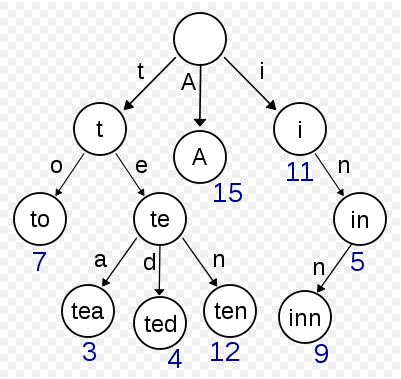A trie, or prefix tree, is a multi-way tree structure useful for storing strings over an alphabet. It is very efficient and handy and can be used for various purposes like auto-complete, spell-check, dictionary search, etc.
The basic idea of a Trie goes as below:
- We have a root node which represents an empty string.
- Every other node either represents a word or a prefix of one or more words.
- Each node can have atmost as many children as the size of the alphabet.
The above diagram shows a trie which stores the words “A”, “to”, “tea”, “ted”, “ten”, “i”, “in”, and “inn”.
Below is my implementation of Trie in javascript:
At each node of Trie, I store the word-count, prefix-count and the link to children.
Trie = function() { this.words = 0; this.prefixes = 0; this.children = []; }; |
To insert a word, I recursively traverse through the trie nodes if they already exist, else I create new nodes. While traversing the nodes, I keep on storing the information in the nodes as I encounter each character in the given string.
insert: function(str, pos) { if(str.length == 0) { //blank string cannot be inserted return; } var T = this, k, child; if(pos === undefined) { pos = 0; } if(pos === str.length) { T.words ++; return; } T.prefixes ++; k = str[pos]; if(T.children[k] === undefined) { //if node for this char doesn't exist, create one T.children[k] = new Trie(); } child = T.children[k]; child.insert(str, pos + 1); } |
Removing a word follows the similar idea as insertion.
To update, I simply remove the existing word and insert the new word.
Searching a word is trivial as we just need to check if the word count at the terminating node of the input string is greater than zero or not.
find: function(str) { if(str.length == 0) { return false; } if(this.countWord(str) > 0) { return true; } else { return false; } } |
You can get the full source code in my GitHub repository
Meanwhile you can see the auto-complete demo using my trie implementation
Links:

Thank you for this implementation. I’ve extended it to work with:
(a) case insensitive matches
(b) to locate matches within a supplied string buffer
(c) removed the definition from global scope
Please contact me if you wish the updated code.
I am just learning about Tries and found this implementation very helpful. I would be interested to see David Brock’s amended code as well, as mentioned in his comment above.